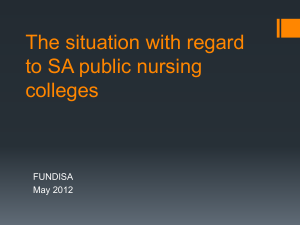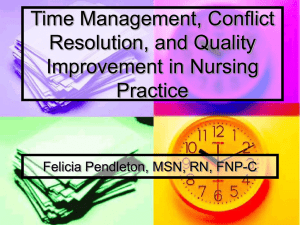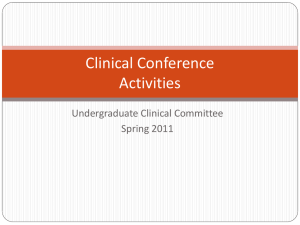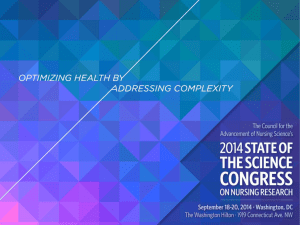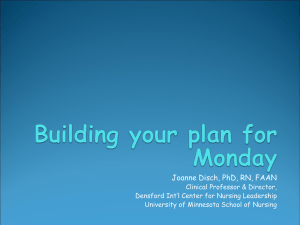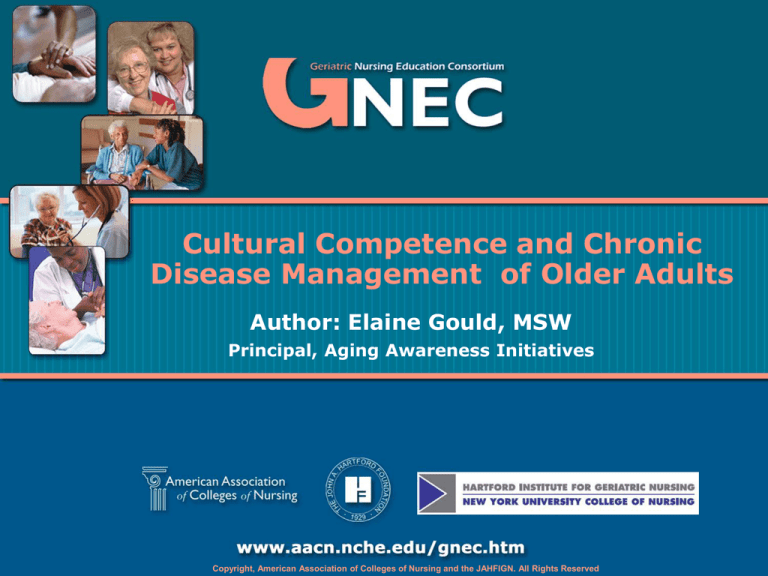
Cultural Competence and Chronic
Disease Management of Older Adults
Author: Elaine Gould, MSW
Principal, Aging Awareness Initiatives
Copyright, American Association of Colleges of Nursing and the JAHFIGN. All Rights Reserved
Learner Objectives
1. Be able to maximize patient trust and
communication effectiveness in the clinical
encounter for older adults with chronic
illness.
2. Understand and utilize specific techniques
that demonstrate cultural sensitivity in order
to provide effective person-centered care to
older adults with chronic illness.
3. Understand ways to influence an
organization’s ability to be culturally
competent.
Copyright, American Association of Colleges of Nursing and the JAHFIGN. All Rights Reserved
AACN Cultural Competence
Standards and Tool Kits
This module builds on the
assumption that students have
had an initial introduction to
cultural competence in their
BSN curriculum.
Copyright, American Association of Colleges of Nursing and the JAHFIGN. All Rights Reserved
Culture - Definition
Culture:
A set of beliefs, attitudes, behaviors, and
policies to which people identify and adhere.
Is the sum total of ways of living including:
> Behavioral norms
> Language
> Communication style
> Patterns of thinking
> Beliefs and Values
(Center for Cultural Education, 2007)
Copyright, American Association of Colleges of Nursing and the JAHFIGN. All Rights Reserved
Many Determinants of “Culture”
Defined by:
1. Grouping / Setting
– ethnic, racial, religious,
corporate, professional,
age, socioeconomic
status, sexual orientation
2. Self-identification
3. Stereotyping by others
Copyright, American Association of Colleges of Nursing and the JAHFIGN. All Rights Reserved
“Active Culture”
Even though we may share a
general culture with other
people, each of us has a special
set of experiences and
influences that makes us
unique.
Active Culture is fluid – it
changes with time, experience,
and circumstances.
Copyright, American Association of Colleges of Nursing and the JAHFIGN. All Rights Reserved
Culture Creates Bias
Personal view of provider
Personal view of patient – older adult
Family view
Interdisciplinary team view
Organizational setting perspective: acute,
primary, homecare, long-term care,
hospice
Copyright, American Association of Colleges of Nursing and the JAHFIGN. All Rights Reserved
Culture Influences
Components of Health Care
Attitudes and behaviors
about health and illness
Beliefs about causes of
disease
Possible Treatments
Expectations that older
adults have about care
provider
Expectations that
providers have about
older adults and their
cultural identification
Communication among all
participants
Copyright, American Association of Colleges of Nursing and the JAHFIGN. All Rights Reserved
Culture Influences Chronic Disease
Management of Older Adults
Western Medicine
management of older
adults with chronic
conditions.
Goal
Maximize
Function
Other cultures may not have this goal!
Culture influences:
Older adult TRUST of health care provider and system
COLLABORATIVE behavior of provider and older adult
Readiness and ability of older adult to ADHERE to a care plan
CARE PLAN that is both therapeutic and practical
Copyright, American Association of Colleges of Nursing and the JAHFIGN. All Rights Reserved
Cultural Competence
and Cultural Humility
Cultural Competence implies having the capacity to function
effectively as an individual and an organization within the
context of the cultural beliefs, behaviors, and needs
presented by consumers and their communities.
(Cross, 1989)
Cultural Humility – commitment to developing mutually
beneficial and non-paternalistic clinical relationships with
patients and communities.
(Turvalon, Murray-Garcia 1998)
Copyright, American Association of Colleges of Nursing and the JAHFIGN. All Rights Reserved
Benefits of Cultural Competence
More accurate diagnosis
More effective care plans
and patient adherence
Earlier participation in
health care
Enhanced communication
and satisfaction of
patients and providers
Respond to health care
disparities
Cost-saving - More
effective use of health
care services
Decreased litigation
Copyright, American Association of Colleges of Nursing and the JAHFIGN. All Rights Reserved
Cultural Competence Standards
Federal
States
Civil Rights Act ( Title VII 1964)
Conditions of licensure
Medicare Managed care
requirements
Continuing education
requirements
Medicaid requirements
HHS – Office of Minority Health
- national CLAS (culturally and
linguistically appropriate
services) standards
Healthcare Industry SelfRegulation
JCAHO – Joint Commission
NCQA – National Committee
for Quality Assurance
Accreditation council for
Graduate Medical Education
Copyright, American Association of Colleges of Nursing and the JAHFIGN. All Rights Reserved
Teaching About: Culture
Have students identify
their own cultural
backgrounds and biases
about health care
Have students interview
an older adult about that
person’s culture and
views on health care
Have students look on the
Internet for Cultural
Competence Standards
(federal, state, healthcare
industry regulations)
Students read and
comment on the following
books: Fadiman (1997),
Boyle (1995), and Baylor
and Chana (1990).
Copyright, American Association of Colleges of Nursing and the JAHFIGN. All Rights Reserved
Teaching about: Culture
Have students read the following suggested nursing texts:
Ebersole (2008)
Leinenger & McFarland (2002)
Leinenger & McFarland (2006)
Andrews & Boyle (2008)
Purnell & Paulanka (2008)
Copyright, American Association of Colleges of Nursing and the JAHFIGN. All Rights Reserved
Summary of Cultural Barriers that Affect
Communication with Older Adults
1. Beliefs
2. Expectations
3. Stereotyping
4. Language
5. Health Literacy
6. Genetic Trends
7. Professional Prisms
8. Mistrust
9. Provider Dominance
10. Geriatric Syndromes
11. Life Experiences
Copyright, American Association of Colleges of Nursing and the JAHFIGN. All Rights Reserved
Barrier 1: Beliefs – 5 Domains
Respect
> Who gets respect - how old age is respected; influence of healers, religious leaders, medical
professionals - RNs MDs; appropriate or inappropriate behaviors to show respect– personal
space, body language, words.
Nutrition/Medication
> Level of acceptance of Western medicine; cultural foods and medicines used, alternative
medicines.
Pain
> How it is interpreted – a biological phenomenon or a punishment from God?
Death
> Definition of death - when is a person dead; what happens when a person dies - where do they
go; what happens to those remaining; attitudes about interference in dying process -“assistance” toward death or “prolonging” life, advance directives; quality of life issues.
Time
> Ability to “tell time” – Use of a clock and the concept of an hour, respect for time and what time
implies – adhering to regimens, being prompt or late.
Copyright, American Association of Colleges of Nursing and the JAHFIGN. All Rights Reserved
Teaching about Cultural Barriers:
Belief Domains and their Impact
Students self-identify own
cultural beliefs regarding 5
domains.
Students interview an older
adult about his/her cultural
beliefs regarding 5 domains
and their chronic illnesses.
Students examine how 5
belief domains influence the
4 components of chronic care
of older adults: trust,
collaboration, adherence, and
care plans.
Students study one
culture or ethnic group
in-depth to understand
basic beliefs and
customs.
Students find
publications about a
particular ethnic
group’s healthcare
beliefs and compare
those to interview.
Copyright, American Association of Colleges of Nursing and the JAHFIGN. All Rights Reserved
Cultural Barriers (cont.)
Barrier 2: Expectations of behavior based on beliefs
Need to know each other’s beliefs so that we can have comparable
expectations about behavior.
Barrier 3: Stereotyping
Misuses of individual characteristics and trends.
“Exaggerated beliefs or fixed ideas about a person or group and
sustained by selective perception and forgetting.”
Copyright, American Association of Colleges of Nursing and the JAHFIGN. All Rights Reserved
Cultural Barriers (cont.)
Barrier 4: Language differences
Barrier 5: Low health literacy of older
adults and families
Science literacy – understanding how
the body works; the concept of a
therapeutic dose; the difference between
viruses and bacteria.
Copyright, American Association of Colleges of Nursing and the JAHFIGN. All Rights Reserved
Teaching about Cultural Barriers : Expectations,
Stereotypes, Language, Health Literacy
Students identify own
expectations about older adults
participation in health care
Students identify stereotypes of
older adults with chronic
diseases
Students interview a provider
about descriptions of a specific
ethnic group and compare
against references about
specific cultures such as those
in Purnell and Paulanka (2008)
Transcultural Healthcare
Students interview professional
interpreter and or investigate
regulations about language
services.
Students interview older adults
with chronic diseases about
their health knowledge of the
disease
Copyright, American Association of Colleges of Nursing and the JAHFIGN. All Rights Reserved
Cultural Barriers (cont.)
Barrier 6: Older Adult and family Mistrust of health care
system
Based on collection of poor health care experiences
Lack of patient/provider cultural concordance
Barrier 7: Provider lack of understanding of genetic trends –
physiological and biological
Diseases that are prevalent in certain races and ethnic groups
Trends in responses to medications base on race or ethnic identity
Copyright, American Association of Colleges of Nursing and the JAHFIGN. All Rights Reserved
Cultural Barriers (cont.)
Barrier 8: Provider’s Professional Prism
MD, RN, MSW, PharmD
the culture of medicine
Lack of understanding of non-Western medicines
Barrier 9: Provider Dominance instead of collaboration
Use of provider-focused compliance approach (rather than
collaborative adherence)
Conciliatory resistance – patient response to dominance
Resistance seen as “bad” rather than as a source of additional
information
Copyright, American Association of Colleges of Nursing and the JAHFIGN. All Rights Reserved
Teaching about Cultural Barriers: Mistrust,
Genetic Trends, Provider Prisms, Provider Dominance
Interview older adults of
different ethnicities to find
out about levels of
mistrust of the healthcare
system
Study genetic trends of
differing ethnic groups
Interview providers about
professional biases
Interview providers about
their frustrations and
techniques to enhance
communication with older
adults with chronic
conditions
Copyright, American Association of Colleges of Nursing and the JAHFIGN. All Rights Reserved
Cultural Barriers (cont.)
Barrier 10: Cultural responses to Chronic/Geriatric
Syndromes
> sensory losses -- hearing, vision
> cognitive losses -- executive function, depression, dementia
> syndromes that affect activities of daily living
Barrier 11: Cultural Responses to Life Experiences of older
adults–
> historical events, levels of assimilation, socio-economic factors
Copyright, American Association of Colleges of Nursing and the JAHFIGN. All Rights Reserved
Teaching about Cultural Barriers:
Interplay of Cultural Response to Geriatric/
Chronic Syndromes and Life Experiences
Interview older adults
about how their specific
culture views their chronic
conditions.
Interview older adults
about how cultural and
historical experiences
affect how they approach
health care.
Copyright, American Association of Colleges of Nursing and the JAHFIGN. All Rights Reserved
Solutions for Culturally Competent Care
to Older Adults with Chronic Illness
Create
Trust
Recognize barriers – cultural and geriatric
Ask about beliefs
Work within belief systems
Use professional interpreters
Verbal and Non-verbal communication skills
Transcultural Nursing ASSESSMENT
8 QUESTIONS for Patient’s Explanatory
Model of Illness
8. LEARN Model for communication in clinical
encounter
9. ETHNIC Framework for communication in
clinical encounter
10. Organizational level activities
1.
2.
3.
4.
5.
6.
7.
Copyright, American Association of Colleges of Nursing and the JAHFIGN. All Rights Reserved
Solutions to Create Cultural
Competence: Create Trust
Solution 1: Recognize the barriers that influence the clinical
encounter – cultural and geriatric
Solution 2: Ask about beliefs as relevant to goal of particular
encounter – respect, nutrition, pain, death, time
Solution 3: Work within the belief system when possible
Solution 4: Use language interpreters – professional
preferred over family
Copyright, American Association of Colleges of Nursing and the JAHFIGN. All Rights Reserved
Solution 5: Verbal and Non-verbal
Communication to Foster Respect
Ask about older adult’s
cultural preferences
regarding:
Eye contact
Pace of conversation –
silences, interruptions
Body movements
Language literacy
Physical distance
Emotional expressiveness
Touch
Modesty
Copyright, American Association of Colleges of Nursing and the JAHFIGN. All Rights Reserved
Solution 6: Transcultural
Nursing Assessment
6 Areas of Human Diversity
Communication
ie language, intonation, silence
Space
body movement, positioning to others
Social Orientation
roles, respect, economic and educational status,
assimilation, spiritual, psychological orientation
Time
perceived, measured and valued differently
Environmental Control
how much control a person has over his
environment, cleanliness, personal history
Biological Variations
physiological and genetic trends
(Geiger and Davidhizar , 2008)
Copyright, American Association of Colleges of Nursing and the JAHFIGN. All Rights Reserved
Solution 7: 8 Questions to elicit
Patient’s Explanatory Model of Illness
1. What do you call the problem?
2. What do you think caused the problem?
3. Why do you think it started when it did?
4. What do you think the sickness does?
5. How severe is the illness?
6. How has the sickness affected your life?
7. What kind of treatment do you think you should receive?
8. What do you fear most about the illness?
Copyright, American Association of Colleges of Nursing and the JAHFIGN. All Rights Reserved
Solution 8: LEARN Model
Guide in the Clinical Encounter
L
Listen with empathy and understanding to the patient’s
perception of the problem
E
Explain your perceptions of the problem
A
Acknowledge and discuss the differences and similarities
R
Recommend treatment / solution
N
Negotiate agreement
(Berlin and Fowkes)
Copyright, American Association of Colleges of Nursing and the JAHFIGN. All Rights Reserved
Solution 9: ETHNIC Framework
Guide in the Clinical Encounter
E
T
H
N
I
Explanation – older adult explains view of illness and causes
C
Collaboration – work with patient, family, and healers to
maximize adherence to agreed care plan. Readjust as needed.
Treatment – older adult explains utilization of personal
treatments
Healers – older adult explains alternative influences for advice
and medication outside of healthcare provider
Negotiate – negotiate health care plan based on beliefs and
readiness
Intervention – finalize an agreed upon plan of care for a
specific period of time
Copyright, American Association of Colleges of Nursing and the JAHFIGN. All Rights Reserved
Solutions 10: Organizational Level Activities
to Enhance Cultural Competence of Older Adults
with Chronic Disease
Use of professional
interpreter services
Use of community health
workers
Recruitment and retention of
multicultural staff –
congruent with patients
Culturally competent health
promotion patient education
materials
Provider training on
culturally sensitive
communication
Inclusion of family and/or
community members
Coordination with traditional
healers
Administrative and
organizational
accommodations –
scheduling, gender
preferences of providers
(Brach & Fraser, 2000)
Copyright, American Association of Colleges of Nursing and the JAHFIGN. All Rights Reserved
Solutions 10: Organizational Level Activities
to Enhance Cultural Competence of Older Adults
with Chronic Disease (cont.)
Adopt all national and
professional guidelines
about cultural competence
Conduct periodically cultural
competence proficiency
assessments of the
organization and individuals
Prepare annual organizational
progress report based on
national cultural competency
standards
Chart notation of patient
cultural self-identification and
primary language
Copyright, American Association of Colleges of Nursing and the JAHFIGN. All Rights Reserved
Teaching about:
Solutions for Cultural Competence
Students role play verbal and
non-verbal communication skills
Students use the Transcultural
Nursing Assessment on fellow
students or patients
Leadership students conduct an
organizational level cultural
competence proficiency
assessment in a clinical setting
and report to leadership of that
organization
Students take the Cultural
Students role play using the 8
Competence Health Practitioner
Questions, LEARN and ETHNIC
Assessment (CCHPA) of The
models
National Center for Cultural
Competence
Students use the 8 Questions,
LEARN and ETHNIC models in
a clinical encounter and analyze
difficulties and effectiveness
Copyright, American Association of Colleges of Nursing and the JAHFIGN. All Rights Reserved
Teaching about: Culture and Chronic
Diseases of Older Adults - Summary Project
Students choose a topic below and investigate about
how a particular culture specifically influences a
chronic disease, condition, or healthcare topic
important to care of older adults
•
•
•
•
•
•
•
Diabetes
Cancer
CHF
Arthritis
Incontinence
Depression
Dementia
•Advance Directives
•Palliative Care
•End-of-life care
•Loss of independence
•Pain management
•Medication management
Copyright, American Association of Colleges of Nursing and the JAHFIGN. All Rights Reserved
Cultural Competence Websites
AACN Cultural Competency in Baccalaureate Nursing Education
Tool Kit of Resources for Culturally Competent Education for Baccalaureate
Nurses. www.aacn.Nche.edu/Education/cultural.htm
CLAS: A-Z: Practical Guide for Implementing the National Standards in
Culturally and Linguistically Appropriate Services (CLAS) in Health Care
www.minorityhealth.hhs.gov/assets/pdf/checked/CLAS_a2z.pdf
Hartford Institute for Geriatric Nursing, NYU College of Nursing. Clinical
website: www.ConsultGeriRN.org topic: ethnogeriatrics
Stanford University Curriculum for Ethnogeriatrics.
http://www.stanford.edu/group/ethnoger/index.html
Cultural Competency Continuing Education Programs (CCCEP of the US
Center for Disease Control) and Culturally Competent Nursing Models – part
of the CLAS listing at www.thinkculturalhealth.org
Copyright, American Association of Colleges of Nursing and the JAHFIGN. All Rights Reserved
Cultural Competence Websites
(cont.)
National Center for Cultural Competence. Georgetown University
www11.georgetown.edu/research/gucchd/nccc/ersity.
National Center for Cultural Competence www.nccccurricula.info
Transcultural Nursing
www.Culturediversity.org
Transcultural Nursing Society www.tcns.org
Leininger’s Discussion Board www.Madeleine-leininger.com/en/index.shtml
Cultural Competence Self-Assessment Protocol for Health Care Organizations
and Systems ( no date) developed by Andrulis, Delbanco, Avakian and ShawTaylor Available at http://erc.msh.org/provider/andrulis.pdf
Cross Cultural Health Care Program, Seattle Washington. www.xculture.org
Resources for Cross Cultural Healthcare www.diversityRx.org
Copyright, American Association of Colleges of Nursing and the JAHFIGN. All Rights Reserved
References
References are found on this
slide’s Notes Page.
Copyright, American Association of Colleges of Nursing and the JAHFIGN. All Rights Reserved

